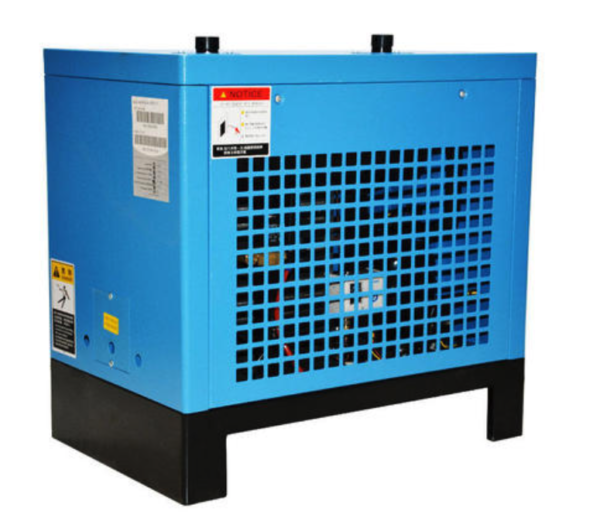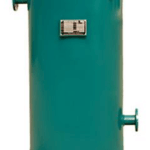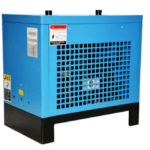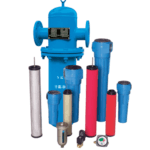Contents
Not all air compressor dryers are created equal. Knowing the different types of air compressor dryers will help you understand how they work, what problems or benefits they have, and which ones are appropriate for your application.
Main types of Air compressor dryers
There are three main types of air compressor dryers:
- An oil/moisture separator dryer
- A desiccant wheel type of dryer
- A refrigerated dryer or liquid line filter drier (LLFD)
- Chemical Air Dryer
Oil/moisture separator air compressor dryers
Oil/moisture separator air compressor dryers
Oil-water separator air compressor dryers are the simplest and least expensive. To understand how they work, let’s first start with a little background information on moisture in compressed air systems to put the effectiveness into context.
Moisture content in compressed air systems
In a typical oil-injected rotary screw compressor, approximately 7 to 9 pints (3.5 – 4 liters) of ambient temperature condensate will form for every 1000 cubic feet (28.3 m³) of air compressed, and about 3% – 5% of the oil applied will be lost to moisture and varnish formation.
Some compressed air systems may produce as much as 100 pints (45 liters) per 1000 ft³ (28m³).
Effectiveness of oil/moisture separator dryer
The effectiveness of an oil/moisture separator dryer is typically 50% on the first pass and 90% after the second pass. The amount of system makeup air required by a desiccant wheel-type compressor dryer is usually some percentage less than that required by an OWS.
Desiccant wheel type of compressed air dryers
Desiccant wheel type of compressed air dryers
A desiccant wheel type of compressed air dryer typically consists of multiple parallel flow paths separated by fiberglass or metal mesh screens coated with a bed of silica gel beads impregnated with potassium permanganate, manganese dioxide, activated alumina, activated carbon powders, or other suitable chemicals depending on the desired end-use.
Moisture-laden gas enters the top of the desiccant wheel, where its moisture content is transferred to the chemical coating on the desiccant bead surfaces, which absorbs moisture as water of hydration.
The wheel is rotated slowly, either by an attached motor or by the airflow through the wheel to expose progressively more of its surface area to desiccant surfaces as drying progresses. Compressed air exits the wheel through spaces between the beads and drier walls or screens.
An oil/moisture separator dryer will typically have a pressure drop across it of about 10 psi (0.7 bar) for a 50m³/hr volume flow rate, while a desiccant wheel type of compressor dryer may have a pressure drop across it greater than 100 psi (7 bar) for that same air volume flow rate at standard temperature and pressure.
Desiccants do not significantly reduce compressed air volume.
Refrigerated air compressor dryers
Refrigerated air compressor dryers
A refrigerated compressed air dryer is a type of desiccant wheel dryer that uses a refrigeration cycle to cool the desiccant wheel and provide moisture removal. The use of a refrigeration cycle typically allows the use of a smaller, less expensive desiccant wheel and results in lower operating costs.
The refrigerated compressed air dryer requires a source of low pressure, low-temperature refrigeration. This type of compressor may be designed to use either the suction or discharge gas from an existing centrifugal or reciprocating compressor as its refrigerant source.

Liquid line filter driers (LLFDs)
Liquid line filter driers (LLFDs)
A liquid line filter drier (LLFD) is usually a small, cylindrical-shaped metal canister with an internal screen mesh media that is designed to remove both water and oil from the compressed air system. A typical LLFD will have a filtering capacity of 10-15 microns.
Liquid line filter driers are an important part of a compressed air system and should be installed in the compressor discharge line between the compressor and the point where the air is distributed to the users.
Compressed air dryers come in many different types, and it is important to select the correct dryer for the specific application. The three most common types of compressed air dryers are the oil/moisture separator dryer, the desiccant wheel type of compressor dryer, and the refrigerated air compressor dryer.
Each type of compressed air dryer has its unique advantages and disadvantages, and it is important to select the type that will best meet the needs of the specific application.
Chemical Air Dryer
Chemical Air Dryer
Chemical air dryers circulate a liquid chemical through the compressed-air line and also inject the liquid directly into the compressed air as it is being dried. This type of compressed-air dryer can achieve dew points as low as -40°F.
However, liquid injection tends to be less efficient than desiccant wheel drying at removing liquid from very wet systems, and liquid added to the system with this type of dryer may contaminate downstream components such as filters, regulators, and flow meters.
Also, liquid additives injected into the compressed air line with chemical dryers will cause downstream equipment to need more frequent servicing and replacement due to contamination.
Which dryer type is best for your needs?
Which dryer type is best for your needs?
This is a question that can only be answered after careful consideration of the specific application requirements. Each type of compressed air dryer has its unique advantages and disadvantages, and it is important to select the type that will best meet the needs of the specific application.
The oil/moisture separator dryer is the least expensive, but it will require a compressor with at least 2 stages to provide sufficient air pressure, and additional makeup air must be provided to the system to compensate for the air that is being used to dry the compressed air.
The desiccant wheel type of compressor dryer is more expensive, but it can usually be operated at a lower pressure drop than an oil/moisture separator dryer and does not require makeup air.
The refrigerated air compressor dryer is the most expensive, but it typically requires the smallest and least expensive desiccant wheel, and it has the lowest operating costs.
The compressed air dryer that is chosen must be matched to the specific application and should provide reliable dew point control for the lowest possible operating costs.
The best advice for selecting compressed-air equipment is to purchase only quality components from reputable manufacturers who provide technical support and can offer installation assistance. This will minimize both downtime and maintenance costs.









Leave A Comment